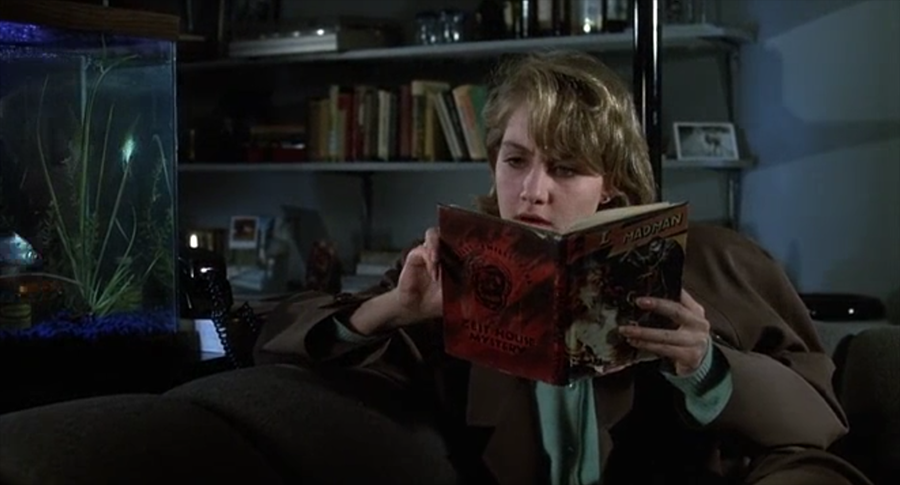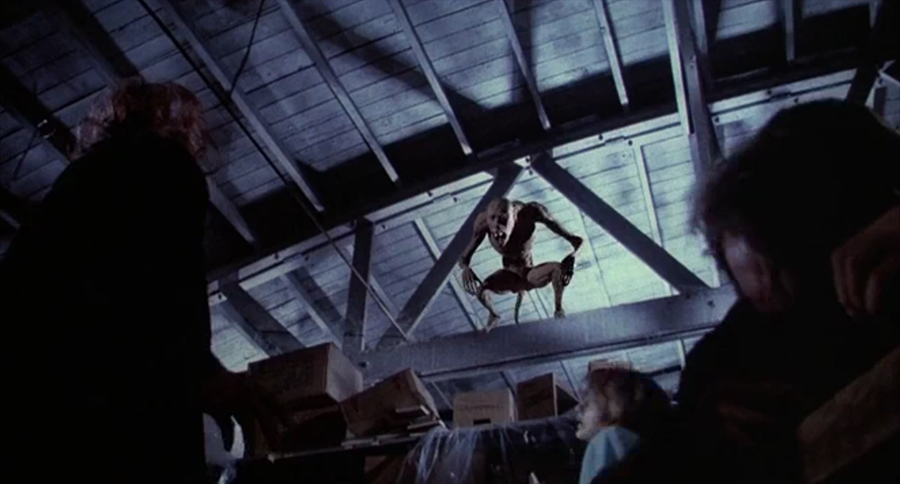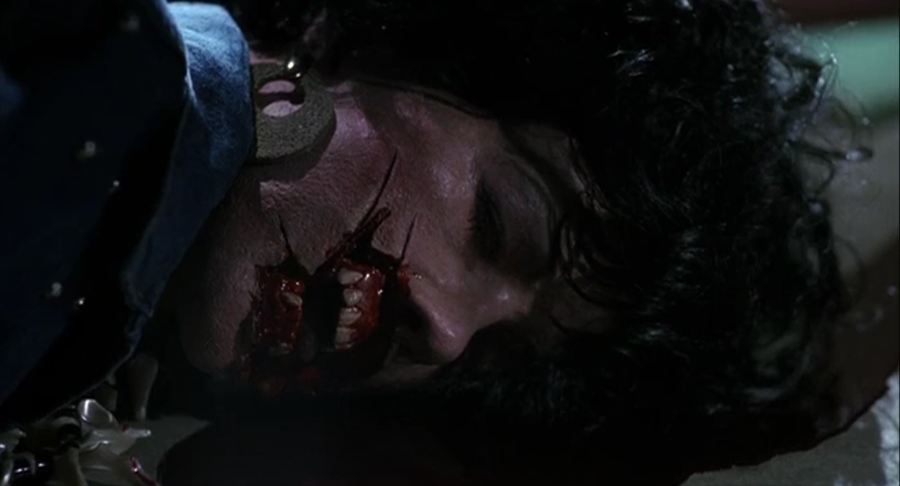I, MADMAN
Directed by Tibor Takacs. 1989. United States.

Tibor Takacs’s 1989 rubber-reality slasher, I, MADMAN, opens with two of my favorite things: stop motion monsters and Jenny Wright in her underwear. The opening scene is a fantastically atmospheric dramatization of the horrific events detailed in the gruesome Malcolm Brand novel that our lead girl, Virginia, is currently obsessed with. She tells her boyfriend, police detective Richard, that Brand makes Stephen King read like Mother Goose. I feel that’s an unfair comparison. Mother Goose wasn’t a real person, and even if she were, I doubt she could afford as much cocaine.
Virginia spends her days working in a used bookstore and her nights attending an improv acting class with her friend, Lenny. Lenny has eyes for Virginia, but Virginia seems only to have time for Malcolm Brand. After finishing one novel, she hungrily begins to devour the next. This novel, I, Madman, was Brand’s last. Brand was a schizophrenic who mutilated himself just like a character in one of his books, the mad doctor Kessler, cutting off his ears and lips, before dying a miserable death, his corpse eaten by dogs.
As Virginia’s obsession with the novel deepens, she begins to be tormented by a man who appears to be deformed in the same ways the fictional Dr. Kessler was. People she knows are being mutilated in ways resembling the novel, each body found with pieces of their faces missing. Is Virginia being targeted by a horror novel character come to life? Is she meant to be the real-life analog for the object of Dr. Kessler’s obsession, doomed to the same grisly fate as her fictional counterpart?

Let’s not beat around the bush too much here. I, MADMAN is a story of two halves, the first good, the second much less so. From the early rubber reality scenes of Virginia wandering off camera, only to reappear in period garb, acting out scenes from the novels she’s reading, to the way Virginia recites the gruesome plot of the book while making love to her boyfriend, I, MADMAN demonstrates a good understanding of why people enjoy horror. The flirtation with darkness, the release it can bring, the delicious way the genre blends flesh and fear, the undeniable draw of that which should not be seen… The movie understands all of it, and it expects you to share in its addiction. There’s a reason the cops in the story all scoff at Virginia’s interest in horror fiction. It’s socially unacceptable in a way. The implication in the story is that by exposing herself to horror fiction, Virginia is somehow corrupting her mind. It’s treated as an outside, negative influence. Horror fans, especially those who grew up in the 80s and 90s, are probably familiar with that line of thinking.
But I, MADMAN is not WES CRAVEN’S NEW NIGHTMARE. It isn’t interested in examining how the fictions of horror can inform the realities of horror. It isn’t a meta-exploration or self-reflective critique. For the first half of the film, we are well within the boundaries of believability to think that all of this is the result of news of a real-world serial killer being processed through the brain of a horror-obsessed reader. Virginia could simply be imagining much of what we see in the movie, or the “Dr. Kessler” Virginia encounters is just a rabid fan of a horror character, adopting that fictional killer’s M.O. as their own. It might even be Lenny, the guy who is clearly (possibly obsessively) in love with our heroine. After all, he IS an actor. Maybe he’s adopting the persona of a character Virginia is far more interested in than him.
But no, before you can say “Stephen King’s The Dark Half”, we are told, in no uncertain terms, that the real-world Dr. Kessler is in fact the same as fictional Dr. Kessler. This is when the second half of the movie starts to ruin the goodwill generated by the first. That first half is crammed full of wonderfully self-aware moments, clever camerawork, and some amazing rubber-reality transitions that rival, well, at least the later A NIGHTMARE ON ELM STREET sequels. It’s strong, great stuff that culminates in a Hitchcockian murder sequence seen through a shop window across the street.

Then it just gets muddled. Virginia discovers some books belonging to Brand that were sold to her shop during his estate sale, books with an occult leaning. Is that what’s to blame for Dr. Kessler invading reality? Is Virginia herself causing not just Dr. Kessler, but a stop-motion demon, to materialize in reality? Is she some sort of conduit, or is she really the real-world Anna Templar, an actress character from the novel, doomed to have her heart cut out by Kessler? If so, who brought them both into reality? Or is this even reality at all? After all, the murders all mirror passages in the book. Are we watching a dramatization within a dramatization? Is the book “reality”? How many layers deep does this go?
These are all great questions. It’s just a shame the film doesn’t even ask them. It entices us into thinking there’s some kind of grand explanation on the horizon, but then just does what slasher movies always do. Characters get bumped off (unfortunately, it’s all off-screen here). Cops fumble around. Our lead has their concerns ignored. It’s routine and unfitting for such a strong premise. In The Dark Half, George Stark is not just a fictional being causing chaos in the reality of it’s creator, Thad Beaumont. Stark is the part of Beaumont containing the darkness necessary for Beaumont to write his horrific material. In trying to retire the pseudonym of George Stark, he attempts to repress the darkness within himself. That darkness, however, fights back.
WES CRAVEN’S NEW NIGHTMARE either took direct inspiration from King’s novel, or Craven heard about the premise and it lodged itself somewhere in his brain. I wish it had done the same for Takacs. I, MADMAN is a perfectly serviceable horror movie, but its unwillingness to engage with its own subtext lets it down. I wish they had kept the same creative and thoughtful energy of the first running through the second. All the pieces were in place for this to be one of the greats. It doesn’t live up to its potential, I’m afraid.